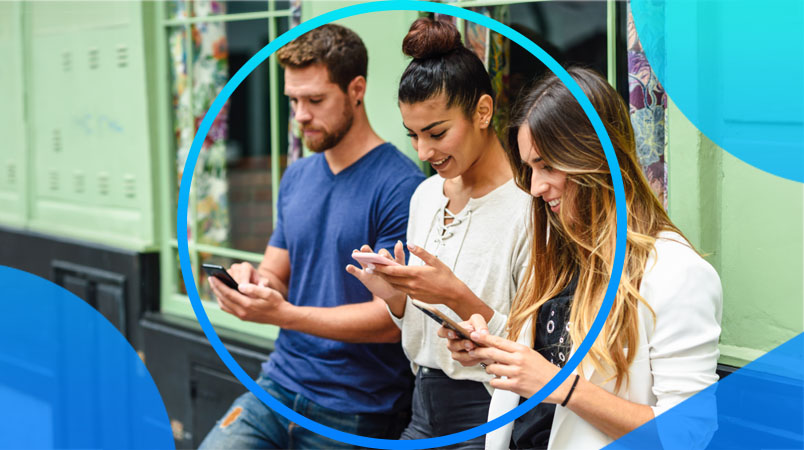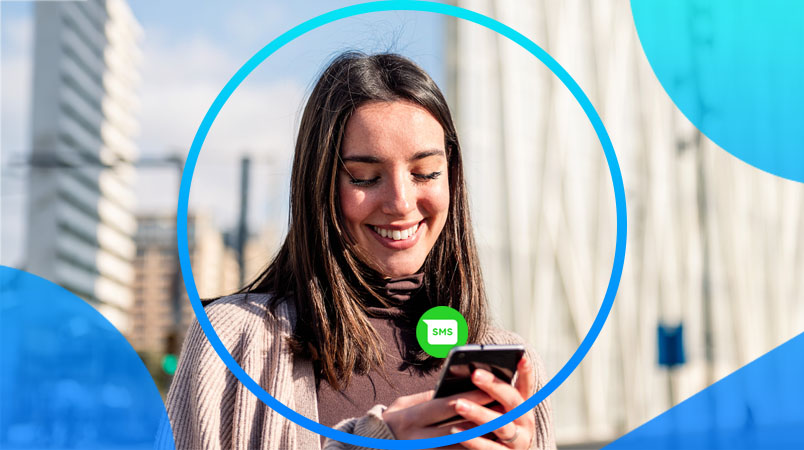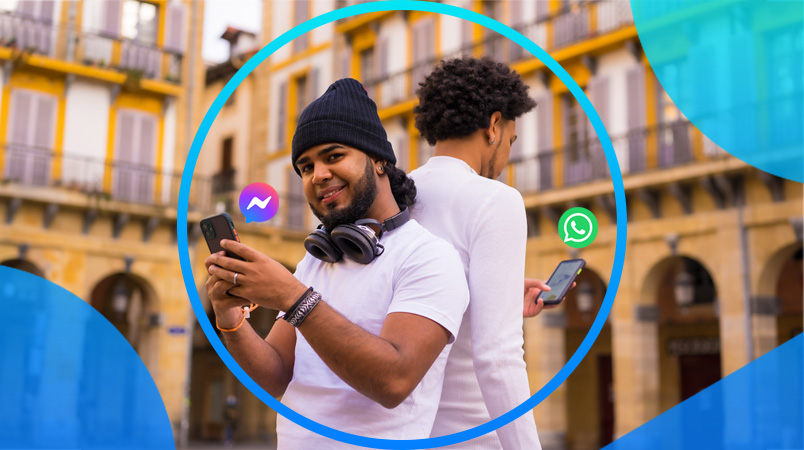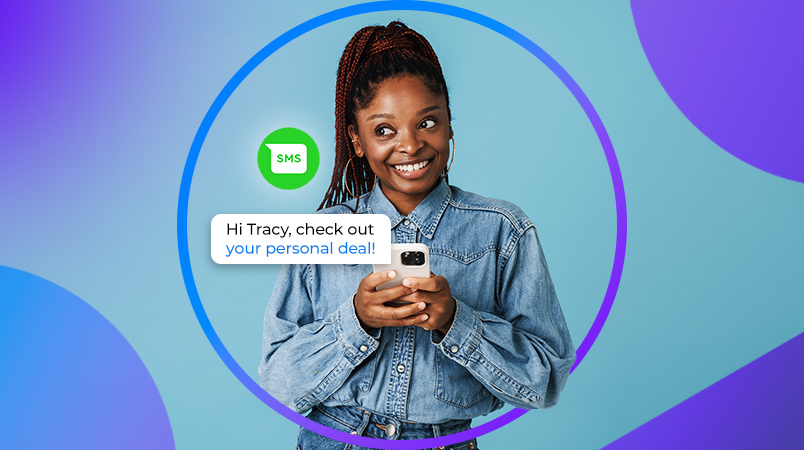Often using plain-old SMS as its medium, A2P provides a way for machines to message humans, organisations sending you texts direct from a their platform or app. If you’ve stayed in a hotel or taken a flight recently, the text message you received confirming your booking came from an A2P messaging provider.
What’s great about A2P is its lack of drama. It’s simple, it reaches the device you’re always carrying, and it’s practically foolproof. Like most technologies that do something simple but useful, A2P has found utility far beyond its original purpose.
From P2P to A2P: How Application-to-Person messaging works
P2P you already know: it’s the messages you exchange with your friends and family, with a human being at each end of the conversation. A2P replaces one party (the sender) with software, often connected to company databases and marketing platforms.
While some countries classify A2P as any messaging sent by a machine (which would include WhatsApp and email!) most people understand A2P as an application of SMS. And that’s the main reason it works so well.
Decades-old, still working: The benefits of SMS
SMS messaging works at the network level: the operator “knows” what’s happened to the message, with its status communicated back to the sender. There are four: SENT, DELIVERED, FAILED, and UNDELIVERED. Because of these standard responses, an A2P application can act on feedback and flag errors that keep the database of phone numbers fresh.
SENT simply means the message is on its way. DELIVERED means the send was successful, with the message reaching the recipient’s phone; this helps to determine how many people were successfully reached (of course, that doesn’t mean they read it – but a very high number of texts are read within minutes). FAILED is equally obvious: something’s gone wrong on the network, and your message can’t continue. While UNDELIVERED indicates the fault is at your end: usually an incorrect phone number or format, which prompts you to correct it.
SMS use cases for business communication
Sounds simple? It is. And that’s the main benefit of using SMS: it’s crystal clear how up-to-date your database is. Today, A2P messaging is suitable for a huge number of use cases. Let’s look at a few.
Notifications and confirmations: Simple updates
The majority of A2P messaging today involves travel and transport. What’s the common denominator? All of them rely on someone or something being in a certain place, at a certain time. Airline tickets, hotel bookings, and package deliveries: all benefit from customers being able to see timely updates and confirmations.
The useful part here is that A2P can include a response mechanism, providing (for example) a number to call if a reservation needs to change. This simple trick can reduce unexpected no-shows—which cost the hospitality industry a lot.
Post-job surveys: Gathering customer intelligence
The best time to survey someone about the service they received is straight after the job’s complete. So many service companies—from plumbers to delivery drivers—set up action pathways that send a survey SMS to a customer whenever the tradesperson leaves. Using A2P messaging means this happens automatically.
Of course, SMS messages are simple and short, which boosts response rates. A popular survey method is the “Ultimate Question” of the Net Promoter Score, “Would you recommend us to friends and family?” The customer is asked to respond with a number from 1 (no) to 10 (definitely).
One Time Passwords (OTP)
A huge and growing part of A2P text messaging involves security. Lost a password? The website will let you reset it—but you’ll need to enter a six-digit number texted to your phone first. That message is generated by A2P. And if you make an unusual bank transaction, the bank will frequently ask you to confirm your identity by doing the same. These are called One Time Passwords, or OTPs.
This is another reason A2P using SMS persists in a world of many communications channels. People tend to keep their phones close at hand, 24 hours a day, and most are used only by one person. So texting an OTP adds a strong layer of security. And A2P can send them out in seconds, millions of times a day, without wasting the customer’s time.
Emergency alerts
Of course, A2P is timely. While at the network level SMS isn’t quite instant (and was never designed to be) it’s rare for one to take more than a minute; a few seconds is more normal. This means A2P has found great utility in emergency alerts of many kinds.
In a hospital, emergency situations (such as a major car crash) have a prewritten response plan to bring the right people and resources together to meet and treat the arriving patients. This team effort is often coordinated by SMS; users appreciate the short, sharp, automated messages telling them what’s happened and where to be. Similar procedures enable aircrews, warehouse workers, and building services to swing into action in defined circumstances. A2P provides the simple messaging underlay to their roles.
One-to-one marketing channel
Marketers, of course, use A2P messaging to send promotional campaigns and special offers to thousands of people at a time. The application is linked to the marketer’s database or other software, like CRM (Customer Relationship Management), and can personalise and customise messages, too—like including the recipient’s first name.
Most countries have strong regulations around SMS marketing, with many requiring double-opt-in before you’re allowed to send a consumer a text. Fortunately, most companies obey such rules.
Competitions, voting, and charities
Mainstream “old media” like television has many uses for A2P messaging. Many talent shows, online competitions, and national events feature telephone voting; A2P lets viewers vote by sending an SMS, with the response recorded and a confirmatory SMS sent back.
There’s another benefit of using A2P messaging, and it’s financial. Companies can charge consumers when they send an SMS, with the charge appearing on the consumer’s phone bill. It’s a simple way for users to pay small amounts and is heavily used in the world’s poorer regions for everyday payments.
A2P 10DLC: US-specific advantages
In the United States, A2P carries a bonus. Small and midsize businesses (those wanting to send under 3,000 text messages a day—which includes some fairly large organizations!) can send texts from and to normal 10-digit long codes (i.e. normal mobile phone numbers) with less hassle. As long as the volumes aren’t excessive, deliverability will be higher. (Previously, different networks filtered and often blocked SMS messages sent in volumes from a single number, since this resembled spam.)
Read more about 10DLC on our US blog >
All it takes is a couple of registrations with the carrier (about the business itself, the other about the type of messages it wants to send) and you’re ready to roll. No application for short codes is needed. It’s another useful extension of A2P.
A2P messaging turns SMS into smart messaging
If you see a role for timely, relevant, one-to-one messaging to customers in your business, why not explore what CM.com could do for you?








